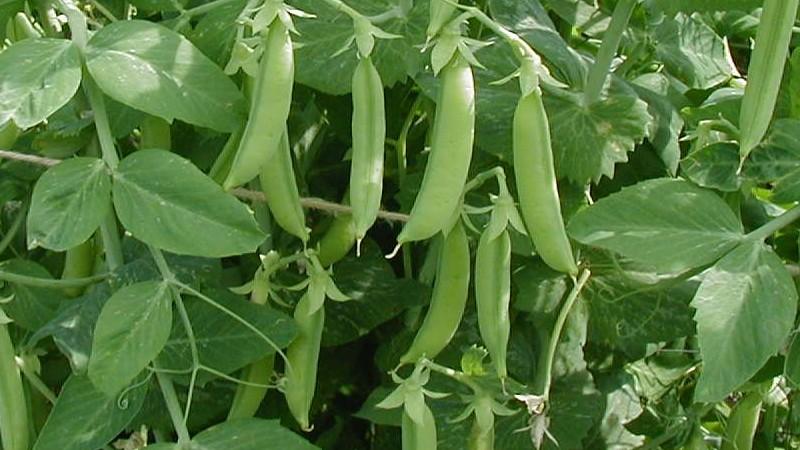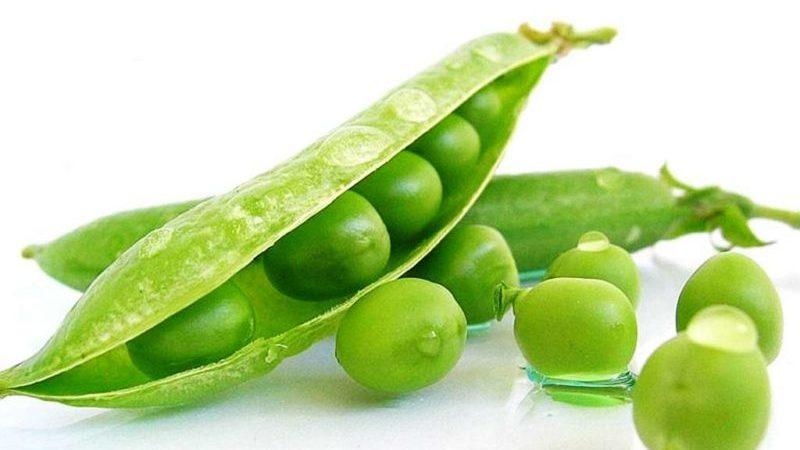Features of growing green peas
Recently, an interesting survey was conducted on the Internet. The gardeners were asked which crop on their site should be looked after least of all. More than half of the respondents answered that for peas.
It turns out that growing this plant is very easy. Consider how useful peas are, what are the features and secrets of growing them.
The content of the article
About pod peas
Peas Is a herbaceous plant from the legume family. Its fruits are pods, inside of which round green peas ripen. This is how the growing peas look in the photo:

Seed peas are of two types: sugar and shell peas... For cultivation on personal plots, they often use peeling varieties intended for eating peas. Experienced gardeners speak best of the early Alpha and Gloriosa varieties.
The yield of green peas, depending on the variety, is 0.5-2 kg per square meter.
Peas are traditionally used in four types:
- fresh;
- canned;
- ice cream;
- dried.
The average values of proteins / fats / carbohydrates (BJU) in green peas are 5 g / 0.2 g / 13 g.
Recipes There are as many cooking dishes from this product as there are varieties of peas.
The benefits and harms of peas
Consider how useful and harmful peas are for humans:
| Beneficial features | Negative action |
| Contains many vitamins and minerals necessary for the human body. | Causes increased gas production (both processed and fresh). It is not recommended to use in large quantities. |
| A source of easily digestible protein. Not inferior to meat. | May cause allergies. It is better for people prone to allergies to refuse this product. |
| Low-calorie product. The calorie content of fresh green peas is 55 calories per 100 g. Thanks to this, green peas give good results when losing weight. | |
| Contains a lot of fiber and fiber, therefore it is good for digestion. |
Features of growing green peas
Peas, like any culture, have features in agricultural technology. Let's consider everything in order.
Sowing dates
Peas are considered a cold-resistant crop. Therefore, seeds are sown even at low temperatures, starting in the second half of April. You can sow peas in new areas every two weeks. This will extend the harvest period. Collect it from late June to September.
Landing
The best predecessors of the green peas in the garden are cucumbers, pumpkin, cabbage, and potatoes.
The peas are planted in the ground, making grooves in the garden at a distance of 50 cm from each other. 5-7 cm are left in the row between the peas. The planting depth is 3-5 cm. The seeds are sprinkled with earth and compacted.
Attention! You shouldn't grow peas in a freshly fertilized bed. All fertilizers will go into the green tops, and there will be few pods.
Care
Pea shoots will appear in about a week.
There is no particular trouble with landings. Care comes down to:
- weeding;
- watering;
- establishing support for plants;
- loosening the top layer of the earth;
- timely harvest.
Watering
Peas do not tolerate heat well. Therefore, it is advisable to water it abundantly. In dry periods, water consumption for irrigation is up to 9-10 liters of water per square meter of planting.
Garter to support
To prevent the peas from spreading on the ground, they need to install a support. It can be a string stretched along a row of peas, or twigs (pegs) stuck into the ground right near the roots of the plant.
A net with large cells, fixed along a row of plants, is also suitable.Polka dots release antennae, which they themselves attach to the support.
Harvesting
When are green peas harvested? Peas bloom in 30-50 days (depending on varieties) after germination... After 2-3 weeks after the start of mass flowering, you can start harvesting. Ripe are considered to be poured smooth green pods (without coarse skin).
Attention! Harvesting is good at stimulating the growth of new pods.
A dozen or two pods can be left on the bush until fully ripe and used as seeds for planting the next year. They will retain their germination for two years.
Prevention of diseases and pests
The main pests of peas are leafworm and pea moth. There are enough chemical means to combat them on the shelves of gardening shops (for example, "Danadim"). But it is undesirable to use chemistry in the garden.
Gardeners in such cases use a folk remedy - garlic tincture. In 10 liters of water, add 100 g of garlic, passed through a garlic press, insist for a day and spray the plants. The tincture is also effective against pea aphids.
reference... To keep the plants from getting sick, it is important to follow the crop rotation schedule. And you shouldn't plant peas in the same garden for several seasons in a row.

From reviews of gardeners
Almost all gardeners emphasize the excellent taste of green peas. They grow it to feast on tender sweet peas, to please themselves and their children and grandchildren.
And here are some secrets that gardeners shared in caring for peas:
Albert, Kazan: “I grow green peas not only to eat tender peas, but also to enrich the soil with nitrogen. After harvesting, I do not pull the plants out of the ground, but mow them down, leaving the hemp. Then, when digging, I embed them in the ground. Great benefit to the soil ".
Galina, Tver region: «I pre-soak the seeds so that they sprout faster and more amicably. I pinch the crown, then the plant does not waste energy on the growth of the tops. Most of all I like the variety Sweet Pearl ".
Conclusion
Peas are a valuable food crop. It contains many vitamins and microelements useful for humans. He also has contraindications and use.
If you decide to grow it on your site, then it will not require much attention to itself. All you need is to plant, tie up and water. Thanks to the extended sowing time (from April to early July), this wonderful plant can be harvested for a long time.